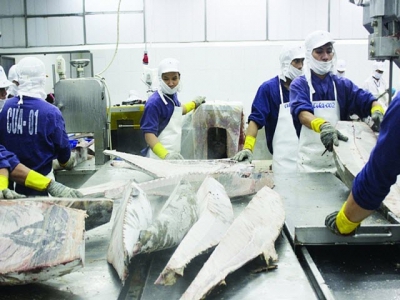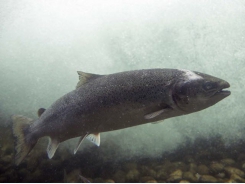Fishery enterprises are in trouble because of IUU yellow card

The burden of seafood exports is accumulating in the last months of the year because exports to the EU market are affected by the IUU yellow card. Businesses are struggling to ensure Vietnamese seafood enters the second largest market.
IUU "yellow card" is the biggest obstacle to Vietnam's seafood exports to the EU in the past two years and in the near future.
Vietnamese seafood businesses are disturbed by the "yellow card"
On October 23, 2017, the EU officially gave the "yellow card" to Vietnamese seafood exported to this market because it has not met the regulations against illegal, unreported and unregulated fishing (IUU). Businesses said that the IUU "yellow card" has caused many negative effects, directly affecting the export of seafood to the EU and the subsequent effect on the US market and other potential markets. Specifically, seafood exports to the EU will decrease because EU customers are afraid of being fined under IUU regulations so they will reduce or stop buying goods from Vietnam. The warning is also published in official EU magazines and websites, worsening the image and adversely affecting the reputation and brand of Vietnam's seafood industry.
During the "yellow card", all seafood containers exported to the EU were detained to check the origin of the fish, causing time to be wasted and incurred costs of checking the origin of £500/container plus fees for the port. But the biggest risk is the large percentage of containers being rejected, the loss of seafood exports to the EU when having the "yellow card" on average can be up to 10,000 euro/container.
Mr. Duong Viet Hoai, Deputy General Director of Baseafood Company (Vung Tau) said that IUU "yellow card" is the biggest obstacle for Vietnam's seafood export to the EU in the past two years and in the future. In particular, the increasing cost of seafood exports to the EU makes Vietnam's seafood difficult to compete with other countries’ seafood and gradually loses its market share. The level of risk and damage is great because if the shipment does not pass the check of origin, the business will lose it all. The IUU "yellow card" also means many commodities such as dried shrimp of Vietnam can’t be exported because they cannot obtain the lawful exploitation certificate, although the EU market is in high demand.
Ms. Cao Thi Kim Lan, Director of Binh Dinh Seafood Joint Stock Company, said that Binh Dinh is one of the provinces with a large number of fishing boats in the Central region, most of which are involved in offshore fishing for export. In particular, the EU is the main export market, accounting for 60-70% of seafood export turnover of Bidifisco. Since Vietnam seafood was warned the IUU "yellow card", exporting to the EU is extremely difficult.
Specifically, although previously exported seafood to the EU was automatically cleared, it is now blocked from the port to check the origin of the exploitation, resulting in a clearance time of 10-15 days. This will not only incur shipping and inspection costs, but also affects the importer's delivery time and business plan. After two years, the proportion of seafood exports to the EU is only 40% of the export value total, reaching about $30 million/year, businesses must search for alternative markets and increase processing to solve the output.
How can Vietnamese seafood enter the EU market?
According to Mr. Nguyen Hoai Nam, Deputy General Secretary of Vietnam Association of Seafood Exporters and Producers (VASEP), the EU is Vietnam's second largest seafood export market after the US, and accounts for over 17% of the total of seafood export value of the whole country in the last three years. After two years of the EU "yellow card" on Vietnam's exploited seafood, Vietnam's seafood exports to EU market have been significantly affected, down 6.5% to nearly $390 million in 2018 and continue to maintain that level in the first eight months of 2019 with $251 million. From the second position in Vietnam's seafood import markets, after the "yellow card", the EU market has dropped to fifth and the proportion of the market has decreased from 18% to 13%.
Due to the impact, businesses have found many ways to manage and maintain for giving key export products into this market. The main export product of Pangasius to the EU is also under the warning. By the end of August 2019, the total of Pangasius exports to the EU market reached $174.3 million, up 8.8% over the previous year. In particular, the four largest import markets are the Netherlands, down 8.3%, the UK up 28.9%, Germany up 33.3% and Belgium up 26% over the same period last year.
However, compared to the first two quarters, starting from May 2019, the export growth rate in some major markets in the EU has slowed down. Currently, some Pangasius exporting enterprises still maintain added value and organic Pangasius products to the Netherlands and Germany. These are products with higher average import prices than traditional frozen fillet products of pangasius.
Ms. Nguyen Thi Thu Sac, Vice President of VASEP, Chairman of VASEP Seafood Committee, said that the Government, ministries, sectors and seafood enterprises have tried their best in combating IUU fishing. So far, 62 seafood enterprises have committed to combat IUU fishing by following the principle of purchasing seafood only from fully-licensed fishing vessels, fishing logs and port fishing certificates.
However, it is still difficult to determine the time to regain the "green card" into the EU for Vietnamese seafood due to inadequacies in the management of fishing activities and the awareness of fishermen's compliance is not high.
According to Ms. Nguyen Thi Thu Sac, the regulation that all offshore fishing vessels must be equipped GPS and monitoring devices is facing many difficulties, partly from funding for equipment, the other part is that fishermen are not aware of their responsibility to comply with IUU fishing rules. Moreover, the management of information on seafood traceability has not been implemented synchronously because there is no software to update information from fishing vessels to ports and purchasing enterprises.
Representatives of the local fisheries sub-departments also said that the overcoming of the IUU "yellow card" should focus on propaganda in the fishing community and owners about illegal fishing activities, recording and filing of logging diary. Tools and reasonable sanctions should be applied for non-compliance cases. At the same time, it is necessary to upgrade the national database on fishing vessels, gear, grounds, ports, the output of seafood raw materials and enterprises purchasing and certifying exploitation so as to monitor compliance with national and international legal procedures.
Related news
Tools

Phối trộn thức ăn chăn nuôi

Pha dung dịch thủy canh

Định mức cho tôm ăn

Phối trộn phân bón NPK

Xác định tỷ lệ tôm sống

Chuyển đổi đơn vị phân bón

Xác định công suất sục khí

Chuyển đổi đơn vị tôm

Tính diện tích nhà kính

Tính thể tích ao



 Exports of seafood unlikely to reach $10 billion
Exports of seafood unlikely to reach $10 billion  Wild salmon pathogens discovered that could pose a…
Wild salmon pathogens discovered that could pose a…